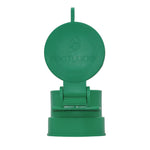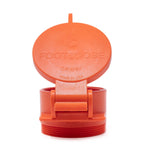You have no items in your shopping cart.
Most people are familiar with the world’s first artificial satellite, Sputnik—highly publicized in October 1957 as being the first man-made object launched into space. In spite of this, a long-standing urban myth argues that Earth’s introduction to sending objects into space occurred earlier that same year—by a manhole cover.
The manhole covers that the public is accustomed to are the kind put over city sewer drains to protect civilians from the dangers of falling into shafts or utility vaults. However, nearly seven decades ago, a specialized manhole cover was created with the purpose not of keeping something from getting in but keeping something out.
It’s hard to imagine how a simple manhole cover, without proper equipment, could possibly end up in space. But in the 1950s, a fateful nuclear experiment gone partially wrong suggests that the seemingly impossible event could have actually been true.
Manhole covers on their own rarely get attention in the media, but the idea of a manhole cover launched into space took the world by storm. In this article, we will take you through one of the most profound—and accidental—scientific experiments ever conducted.
The Background of Operation Plumbob
In the summer of 1957, just months before the Soviets launched Sputnik, Americans were already dabbling in nuclear testing. A total of 29 nuclear tests, known as Operation Plumbob, took place between May and October of that year in the Los Alamos Scientific Laboratory. By July, they decided to move their nuclear tests underground.
The idea to undergo underground nuclear tests was created by nuclear physicists in an effort to protect nearby civilians from toxic fumes being released into the atmosphere. Intended to house the world’s first underground nuclear test, a hole was dug 4 feet wide, 500 feet deep into the earth. Over the top of the hole was five feet of concrete intended to cap the projected explosion.
Contrarily, the nuclear blast ended up having a yield 50,000 times greater than predicted, destroying the round concrete cap and releasing massive amounts of toxic contaminants 100 feet into the air. This test would later become known as Pascal-A.
In August, the next underground manhole cover nuclear test, Pascal-B, was in motion. This time, a 400-foot hole was dug, and at the bottom was a nuclear bomb. Dr. Robert Brownlee was responsible for creating the half-ton concrete manhole cover that would become famous for its incredible velocity. Dr. Brownlee’s math doubted the success of the experiment, but despite his warnings, nuclear physicists decided to continue with the initial plan.
As per Dr. Brownlee’s predictions, the explosion of Pascal-B ended up instantly vaporizing the concrete of the manhole cover, creating an immense amount of pressure beneath the cap. The cap was unable to contain the explosion and blasted upwards at an extremely high speed. Once again, toxic fumes were released into the atmosphere, and the once-trusted manhole cover was nowhere to be found.

Could a Manhole Cover Be the Fastest Object Ever?
Although there is no definite evidence to prove it went to space, many scientists deem the manhole cover used in the Pascal-B experiment to be the fastest object ever made by humans.
Considering the velocity and the speed that this manhole cover had, the thought that it might have reached space is not that far off. According to the math conducted by Dr. Brownlee, the manhole cover is estimated to have left the ground at over 37 miles per second, coming out to a whopping speed of 130,000 mph. Dr. Brownlee described the groundbreaking speed as “more than five times the escape velocity of the planet.”
To offer an idea of just how fast the manhole cover was going, a high-speed camera was placed in front of the explosion as it happened. This camera recorded the nuclear test at one frame per millisecond, and yet, the manhole cover showed up in only one frame. A mere millisecond later, it was gone for good.
Surely, despite the manhole cover being launched so high into the air, it must have landed somewhere on Earth eventually. After all, what goes up must come down—or so one would think.
Where Is the Infamous Manhole Cover Today?
To this day, scientists remain dumbfounded as to the current location of the legendary manhole cover. The most popular theory suggests that the manhole cover was shot up all the way into space—and if it did, it would have reached there even sooner than Sputnik.
Scientists speculated whether the manhole cover would show up somewhere on the ground eventually, but over half a century later, the concrete cap is still missing. Dr. Brownlee himself has publicly confessed that he has no idea what actually happened to the manhole cover, but he assumes the metal must have disintegrated before reaching space. Although, with his calculations, he also said it would not be impossible that the manhole cover launched into space.
Debate surrounding the whereabouts of the manhole cover used in Pascal-B remains heavy. Truthfully, the world may never know what really happened to the manhole cover after the Pascal-B nuclear test.
What Do You Think Happened to Pascal-B’s Cap?
Speculation around the underground manhole cover nuclear test conducted in August 1957 still exists today. Since there remains no concrete evidence to suggest the manhole cover went to space or to suggest that it landed on Earth, it is up to the public to decide whether the first man-made object launched into space was Russia’s notorious Sputnik or if it was indeed nothing other than a manhole cover.
If there is one thing that Pascal-B has taught us, it’s that manhole covers are a lot tougher than they look. Although it was unable to contain the intense pressure of a nuclear bomb, the fact that the manhole cover could very likely have been launched into Earth’s orbit is a testament to its sturdy resilience.
If you are interested in the hulking weight of the manhole covers used in Operation Plumbob, consider checking out our blog post on why manhole covers are so heavy.









